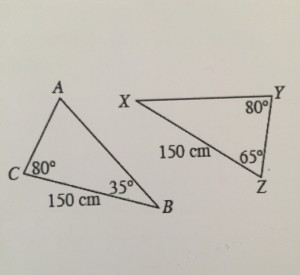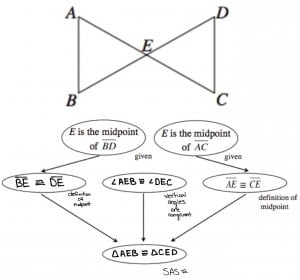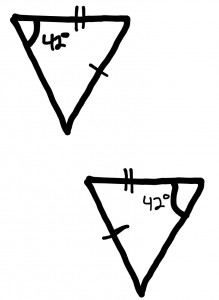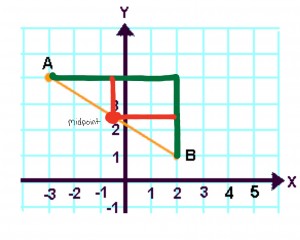AAS ≅ and ASA ≅ 3/14/16
 Today in class we learned the least amount of information you need to tell if a pair of triangles are congruent. If you have all three lengths and angles that are the same then the triangles are congruent, but what if you don’t?
Today in class we learned the least amount of information you need to tell if a pair of triangles are congruent. If you have all three lengths and angles that are the same then the triangles are congruent, but what if you don’t?
I learned that if you have all three angles and one side length are congruent, then the pair of triangles are congruent. Although you have all three angles you may not always have all that information, so the least information you can have is one side length and two angles, AAS ≅ and ASA ≅. You can’t only have three congruent angles because the lengths can still be different without changing the angle measurements. That’s why the least information you can have to tell if the triangles are congruent, is one side length and two angles.
Using Flowcharts 3/15/16
 If you have two triangles and you need to justify how you know they are congruent, you would use a flowchart. A flowchart is like a graphic organizer for showing how you know two triangles are congruent to each other. The flowchart like the one shown at the left are bubbles that have information relating to the triangles. If you are asked to make a flowchart and are given information that’s what you would write down first because you know that is correct information. If you need more information try to write a congruence statement and then write what the statement describes. The terms: given, alternate interior angles, midpoint, or definition of congruence. For the first part of the circles you only need two or more circles. The second part you only need two or more, depending on how much information you put in the first section of circles. The final circle is where you put the correct angles and sides that match up to each other on the other triangle, in the same order.
If you have two triangles and you need to justify how you know they are congruent, you would use a flowchart. A flowchart is like a graphic organizer for showing how you know two triangles are congruent to each other. The flowchart like the one shown at the left are bubbles that have information relating to the triangles. If you are asked to make a flowchart and are given information that’s what you would write down first because you know that is correct information. If you need more information try to write a congruence statement and then write what the statement describes. The terms: given, alternate interior angles, midpoint, or definition of congruence. For the first part of the circles you only need two or more circles. The second part you only need two or more, depending on how much information you put in the first section of circles. The final circle is where you put the correct angles and sides that match up to each other on the other triangle, in the same order.
For example, I was given that E is the midpoint of line segments BD and AC, so I would write it like shown on the left. Don’t forget to write under the bubble what the information in the circle shows. On the triangles I can tell that line segment BE and DE are definition of midpoint. The angles AEB and DEC are vertical angles that are congruent. I still need one piece of information, so I will put the line segments AE is congruent to CE because they are definition of midpoints. For the last circle you put all your information together to create AEB is congruent to CED because they are congruence condition SAS ≅.
Triangle Congruence Conditions 4/1/16
 I learned about triangle congruence conditions in class. Triangle congruence conditions are SAS ≅, AAS ≅, ASA ≅, SSS ≅, and HL ≅ is only for right triangles. To find out what to put for a triangle you have to look at the order of the angles and sides on the triangle.
I learned about triangle congruence conditions in class. Triangle congruence conditions are SAS ≅, AAS ≅, ASA ≅, SSS ≅, and HL ≅ is only for right triangles. To find out what to put for a triangle you have to look at the order of the angles and sides on the triangle.
Using the example of triangles, what triangle congruence condition is the best to describe their congruence? If you look at the order of the angles and sides you should be able to figure out that this is SAS ≅.
Determining a Midpoint 4/11/16
 First of all, a midpoint splits up a line segment or it can split up a triangle like the picture. The line through the triangle is the midpoint. In order to figure out the midpoint you could make a slop triangle and then find the middle of that slope triangle to get the midpoint. For example, if I use a slop triangle on the line segment in the picture I get 3/5. If I split it up evenly I get the midpoint of the line segment AB as (-.50, 2.50).
First of all, a midpoint splits up a line segment or it can split up a triangle like the picture. The line through the triangle is the midpoint. In order to figure out the midpoint you could make a slop triangle and then find the middle of that slope triangle to get the midpoint. For example, if I use a slop triangle on the line segment in the picture I get 3/5. If I split it up evenly I get the midpoint of the line segment AB as (-.50, 2.50).




Leave a Reply